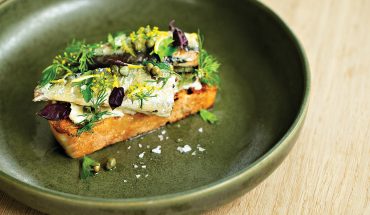Teacher and cookbook author Brigid Washington invites her family to help make Caribbean-influenced comfort food for elevated everyday meals.
as told to Addie Ladner
Brigid Washington is a chef and the author of the cookbook Coconut. Ginger. Shrimp. Rum.: Caribbean Flavors for Every Season, as well as a writer, mom and teacher at North Carolina State University’s Dinah E. Gore Teaching and Research Kitchen. With more time at home—and in the kitchen, keeping her family fed—her cooking habits and go-to recipes have adjusted accordingly. We talked to her about comfort food, cooking for a crowd and letting the kids help—plus, Washington shared some of her go-to recipes for dining at home.
People are being comforted by food and their kitchens during this shelter-in-place order. What was the comfort food of your childhood in the Caribbean and what is it now?
Fresh produce is the natural bent of the islands. And our home cooking reflects that. As a family, we gravitate toward dishes that have heavy punches of citrus and strong verdant aromatics. It was so beautiful out recently. We made grilled mahi-mahi fish tacos, which is a dish completely lifted out of my childhood: mahi-mahi is abundant in Trinidad & Tobago and when topped with mango and bell pepper; we all inhale it.
It seems we have the same cooking ethos; one family, one meal. But even with easy eaters, it’s still been hard for me to get food on the table each day every meal. What’s that been like for you? Any tips?
It’s a lot: Three meals a day, times four people, seven days a week? That’s 84 meals a week, which is very daunting. What works for us is to take control, but also allow the kids into the kitchen. I enjoy cooking by myself, and before the quarantine, my husband would take the kids out to play, then put on Coltrane, pour a bit of champagne and cook, contentedly. Now that everyone is at home, that therapeutic process is gone and I’ve had to take a step back and let the kids into the process.
So what does that look like now? How are you including them and feeding them?
I have about three or four meal options in my head that I pull from and allow the kids to help with. I think the key is for us to keep the meals simple. Our youngest, Noelle, our youngest enjoys mashing bananas for banana bread. Luke, the oldest, has now become passionate about cracking eggs. The process of letting them join has become a rich experience and an inadvertent education. There are lots of teachable moments when cooking and sensory activities that are naturally embedded in the cooking process. At first, I wasn’t ready to relinquish control of my orderly kitchen, but many weeks later, I’ve found that cooking has been a rich educational tool. The kids have become fully engrossed in the process and the kitchen has become our classroom.
What are some things you’ve been making?
As I said before, my cooking isn’t that involved these days. It’s recipes I can make with my eyes closed. When the kids are cooking with me, I only make meals I know by heart so I can take my time and be in the moment with them. At least twice a week, I do a sheet pan of roasted root vegetables. It’s a workhorse meal and the kids love seeing the spread of the kaleidoscope of vegetables. We prepare it in a myriad of different ways; butternut squash, fennel and tomatoes is a favorite. The whole process almost calls for neglect because it’s so simple. I forgot to set a timer and let it sit in there too long the other day and it was fine! So much of my mental state is acute and heightened right now, with news alerts, emails from family checking in on summer plans, and so on, so making something low-maintenance but delicious is essential.
Can you share an easy family meal our readers could make at home? Thank you!
In preparation for an eighteen-week apprentice at the Rome Sustainable Food Project, I tried to absorb as much as I could about the gastronomic heritage of Italy—and practice my fledgling Italian—by spending time with Italian friends whose passion for sustainability mirrored my own. There, a simple chicken dinner taught me more than any of the books I’ve poured over. “Polle al Mattone,” or Chicken Under a Brick, epitomizes the essence of Cucina Povera. It’s the masterful way peasants and country folk cooked what was in their gardens, rivers and chicken coops. They prepared bountiful meals with equal parts economy and elan. Although every global culture can trace prized recipes of yesteryear back to a time of necessity; this brick chicken blunts every stereotype that frugal country cooking is in any way cheap. It’s the very opposite, a triumph. Here’s how to make it, plus a side and dessert that work well:
How to Make Rosemary Brick Chicken
Ingredients
Whole chicken
2 tablespoons of kosher salt
1 tablespoon coarse ground black pepper
1 tablespoon fresh chopped rosemary
1 tablespoon fresh chopped thyme
zest of two lemons
2 tablespoons minced garlic.Preheat the oven to 375. Wrap two bricks in aluminum foil. In a small bowl, combine the salt, pepper, rosemary, thyme, lemon and garlic.
On your largest cutting board, using kitchen shears or a sharp chef’s knife, turn the chicken breast-side down and cut through the backbone and flatten the chicken (this is called spatchcocking.) Place it on a sheet pan, the generously season the bird with the herb mixture. Place the bricks on the bird and bake for an hour. Garnish with rosemary and lemon.
On the Side: Simple Roasted Root Vegetables
A drizzle of extra virgin olive oil, a hearty pinch of coarse kosher salt and a spray of fresh lemon zest lift any range of root vegetables into a satisfying main that is both versatile and nutrient-dense. In my family, fennel, butternut squash and grape tomatoes are a favorite combination. Just chop, season and roast for one hour at 400 degrees.
For Dessert: Triple Berry Galette
A galette is a pastry of beautiful improvisation—one can create their own adaptations and each way it stuns. Here, antioxidant-rich berries are drenched and coated in a bright, sweet burst of lemon juice, sugar and whatever fruit-forward liquor on hand, in this case, Chambord. The result is a simple, yet deeply decadent desert that staves off of the guilt but still hits all the right notes. Fold the fruit into your go-to pie or tart dough recipe of choice and bake for nearly one hour, until the crust is golden brown and the fruit has melted together and begun to bubble. The result is a simple, yet deeply decadent desert that staves off of the guilt but still hits all the right notes.
To make: Preheat oven to 350. Combine strawberries, blueberries or raspberries in a large bowl with the juice of 1 lemon, ½ cup of sugar and a ¼ cup of fruit based liquor. Allow to stand for ten minutes. Ready a basic eggwash. Employ your go-to pastry dough and on a floured surface, roll out to roughly a 14 inch diameter. Transfer the dough unto a sheet pan or perforated pan. Gingerly spoon out the moist berries unto the dough and then roll the edges of the dough to enclose the berries. Using a pastry brush, apply the egg wash. Bake for 45 to 50 minutes until the berries bubble and the crust is golden brown.






